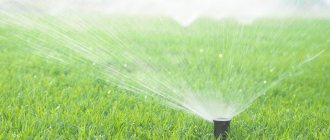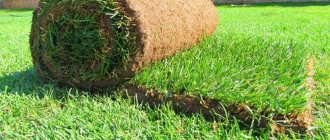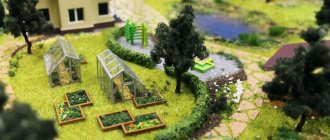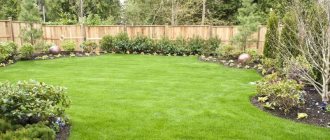Those who want to improve the territory in a short time, without sowing grass and tediously waiting for them to grow, should give preference to a rolled lawn: 1-2 days - and your site will not be a dull wasteland, but a beautiful green lawn!
Today, on private lands, the lawn is taking over more and more territory from the beds. And for good reason. After all, a dacha is intended not only for hard work, but also for relaxation. But sowing and growing lawn grass is not an easy and painstaking task. Laying rolled lawn helps speed up and simplify the process. Anastasia Gordikova, landscape designer of the Hedera Art Studio, spoke about the intricacies of working with him.
Anastasia Gordikova is a graduate of the Kyiv College of Architecture and Design, as well as the National University of Bioresources and Environmental Management of Ukraine. She has been working as a landscape designer, gardener and gardening consultant for more than 5 years. For her, a garden is not just a few trees and bushes planted in a certain pattern, it is a picture painted on the canvas of nature.
+380979424238, www.hedera.com.ua
Laying rolled lawn yourself is a risky business. If something goes wrong during installation, you risk saying goodbye to a tidy sum, because rolled herbs are not cheap. Sometimes owners of country houses unknowingly turn to builders to lay such a lawn (they, as a rule, charge inexpensively and assure that there is nothing complicated in laying the rolls). At first glance, this is true. But the trouble is that builders are not aware of all the intricacies of the “roll”. They may roll it out onto an unleveled surface, stones or peat, or they may not water it, and such a lawn will simply burn in the sun. If you invite landscape designers to the site, then the risk of losing the lawn is possible only due to lack of care for it.
Advantages and disadvantages of rolled lawn
Rolled lawn has a number of advantages. Although it has one drawback, it is quite significant. Therefore, every gardener is free to choose for himself which lawn to give preference to.
Advantages of rolled lawn:
- with its help you can improve the territory in just a few days;
- it can grow even on clay soils, since its turf is about 3 cm thick;
- You can plant trees in any area, even on a slope;
- almost no weeds grow through the dense turf;
- Rolled lawn requires less maintenance than seeded lawn;
- within 3 days after installation you will be able to run, jump and sunbathe on your lawn, while such activity will only be available in a month or two when sowing.
Disadvantage of rolled lawn:
- high price.
The principle of growing rolled lawn
Rolls of lawn grass, which are used for arranging lawns, are grown in two ways. In the first case, “ribbons” of lawn grow on a mesh; in the second, the dense turf itself serves as the basis.
First way . The soil is treated with herbicides, milled, leveled and rolled, after which a net is laid on it. Next, lawn grass is sown and a layer of soil is poured (about 2 cm). Crops are watered daily, preventing the soil from drying out. Subsequently, the roots of the sprouted grass are intertwined with the mesh, and a complete fabric is obtained. Thanks to this, the layer of grass can be easily rolled up.
Second way. A lawn without a mesh is grown according to the same principle as the first method. But it forms such a dense turf that it does not break up into fragments. Such a lawn is cut using special equipment that automatically rolls the “ribbons” into rolls.
Typically, it takes 1.5-2 years to grow a rolled lawn. During this time, the grass grows such a volume of the root system, thanks to which it is securely held in the canvases.
The thickness of the turf can vary depending on what the lawn was grown on. If it grew on peat, then its thickness will be about 1 cm. Such canvases can tear. If the grass grew on black soil, then the thickness of the turf will be 1-2 cm or even more. It is also interesting that the lawn on black soil is so self-sufficient that if it is watered, it can even grow on asphalt.
The grass you buy should be cut and the rolls cut equally. Do not buy lawn if it rains - in this case, the grass in the lawn fields begins to hurt. It's better to postpone the purchase for a few days.
All grasses that make up a lawn are different. Some develop very quickly, others are resistant to trampling, and others are durable. Therefore, it is necessary to buy the grass mixture. If the lawn consists of one type of grass, after some time it will become loose. The optimal grass mixture composition for a rolled lawn is: 50-60% bluegrass, 25% fescue and 15% ryegrass.
Lawn selection criteria
Before purchasing a coating, you need to pay special attention to the varietal and species composition of the plants from which it consists. Often, a rolled lawn consists of:
- meadow and red fescue;
- bentgrass;
- perennial ryegrass.
These plants are highly resistant to frost and drought. It is better to choose coatings with the most diverse composition. The density of the turf layer should be sufficient. It is not advisable to buy lawns with a polymer mesh or with a backing, since these plants grew in greenhouses and are not very well suited for open areas.
It is also unacceptable to have yellowish spots, weeds, insects and bald spots on the coating. To install a rolled lawn, it is better to use the services of specialists. In most cases, companies that sell such coatings also install them. If you wish, you can do the installation yourself, using the recommendations of experts.
How to prepare the area for laying a lawn
Lawn grass rolled into rolls cannot be stored in this state for a long time: it begins to rot very quickly. Therefore, our studio specialists come to the site a few days before the start of work to assess the condition of the soil and plan actions. This is especially true for large garden areas, which take a lot of time to cover.
Step 1. The area is first cleared of weeds, stones and debris. Very often the soil has to be treated with continuous herbicides (for example, Roundup).
Step 2. Next, the area is leveled with a rake. If the soil is heavy, add a layer of chernozem 5-10 cm high. The clay is first “covered” with sand (for drainage), and then with fertile soil (layer thickness 10-20 cm). If the soil, on the contrary, is sandy, clay is poured onto it in a layer of 5 cm or agrotextiles folded in 2 layers are laid, and only after that they are covered with a layer of chernozem.
In an area with sandy soil, before laying the lawn, you must pour a layer of clay on it or put geotextiles on it. Otherwise, the water will go into the soil too quickly, and the grass will have to be watered very often. The water consumption in this case will be colossal.
Step 3. At the next stage, roll the soil with a roller and check whether the surface is level. If necessary, add soil to the recesses and depressions. The soil is filled up to the lower edge of the curb so that after laying the grass stand is higher than the path. This will make it easier to mow with a lawn mower.
To check how well the soil surface is leveled, the rolled soil can be watered. If there are voids in the area, they will show themselves: in these places the soil will sag.
How to lay rolled lawn?
Work begins with mandatory site preparation, which is best done in advance.
Since rolled lawn does not like long-term storage and cannot wait until:
- the area will be cleared of old grass, roots, stones and other large inclusions;
- the territory will be leveled;
- if necessary, humus, sand or black soil are added to the soil, depending on its type.
The coating in convenient rolls will not cause any trouble even for an ordinary summer resident; it is unpretentious and easy to handle. Therefore, you can transform the landscape design of the site yourself, without involving third-party specialists. With some skill and careful preparation, laying a rolled lawn with your own hands on an area of 50 square meters will only take a couple of hours, but the effect of the work will remain for many years.
When ordering a rolled lawn from a manufacturer, it is important to indicate a slightly larger area than the calculations showed. Living material has the ability to shrink in dry weather, and some unforeseen circumstances cannot be ruled out.
The maximum shelf life of rolls does not exceed one day. Therefore, immediately after arriving at the site, the laying material is unloaded. Lay out on a flat surface, in a place protected from the sun so that the grass in rolls does not deform.
When laying, the sides of the panels should fit tightly together, leaving no gaps. When laying out on the ground, one roll should overlap the other by a couple of centimeters. When the grass layer is well pressed, the edges are joined end to end and compacted. In large areas, special rollers are used for such work. The cracks that appear during the laying of the rolled lawn or a little later are immediately filled with sand. Soon, when the vegetation gets used to the new conditions, the narrow ones will be covered with fresh shoots.
If you need to trim the grass along with the turf, it is convenient to use a sharp garden knife. Moreover, such work must be carried out with gloves and in compliance with safety measures.
After completion of all work according to the technology of laying rolled turf, the coating is watered abundantly using sprinklers. In the next two weeks, during acclimatization, the grass root system should not be allowed to dry out. With constant humidity, plants recover faster and begin to grow.
Rules for laying rolled lawn
As a rule, by the time the lawn is laid, the area has already been prepared. This means that the grass is laid on the same day that the rolls are delivered to customers. By what principles do we lay a lawn?
Rule 1. Rolled lawn should be rolled out in strips in one direction, adhering to a checkerboard pattern so that the transverse sections of adjacent strips are not located on the same line.
Rule 2. The edges of the strips should be tightly adjacent to each other. No padding or overlapping layers are allowed.
Rule 3. After laying, the lawn should be “rolled” with a roller and watered thoroughly. Adequate moisture will help the grass establish itself as quickly as possible.
What to do if you didn’t have time to lay all the rolled lawn?
It also happens that it is physically impossible to cover the entire territory in one day. What to do in such a situation with the grass left in rolls, because it quickly deteriorates? Transfer the remaining rolls of lawn grass to the shade or roll them out in an empty area and water them - this will extend the life of the grass for some time.
Please note that laying the rolled lawn should only be done after installing the irrigation system!
Caring for rolled lawns at different times of the year
Home / Caring for roll-up lawns / Caring for roll-up lawns at different times of the year
- Lawn care
- Prices for care
- Care at different times of the year
- Lawn care in spring
- Winter lawn care
- Lawn care in autumn
- Summer lawn care
When solving the problems of creating (sowing) lawns yourself, we would like to draw your attention to general issues regarding care measures:
Care activities in the first year after sowing the lawn
Mowing:
- Mowing is carried out as the grass grows to 8-10 cm. It is carried out to a height of 5-7 cm (no more than 30% of the grass height is removed in one mowing).
- The cutting height increases by 1-2 cm in hot and cold weather. At the same time, the frequency of mowing decreases. Mowing is carried out while the grass is growing.
- If the possibility and design of the mower allows, it is recommended to regularly mow without removing the clippings - this significantly reduces the cost of maintaining the lawn.
Fertilizer:
- Top dressing after the first mowing 150 kg/ha (1.5 kg per 100 m2) “Fertilizer for feeding”
- The following feedings are carried out once every 3-4 weeks, but no later than August 15
Watering:
- The recommended watering rate for an ordinary lawn is 25-30 liters of water per 1 m2 per week (including natural precipitation). Before the second mowing, watering should be done regularly, not allowing the soil to dry out.
- After the third mowing, watering should be done abundantly, but rarely. The recommended frequency of watering is 1-2 times a week. Daily watering leads to the formation of a shallow root system and weakens the lawn.
- Watering can be done in the evening and morning. Watering with very cold water (below 12ºС) is not allowed, as this can lead to severe stress and cessation of the root system, especially in hot weather.
- For irrigation, it is recommended to use special jet-type sprinklers.
Second and subsequent years
Fertilizer:
- Fertilizing with complex fertilizer is carried out 3 times per season (after the first mowing in the spring, in mid-June and at the end of July).
- The application rate (recommended for our “Feeding Fertilizer”) is 2-2.5 kg per 100 m2.
- Fertilizing is carried out after the next mowing. After applying the fertilizer, watering is carried out.
- If necessary (for example, after heavy rains), additional fertilizing with nitrogen fertilizer is applied. For this, urea is used in an amount of 1-1.2 kg per 100 m2. Fertilizing with urea should be carried out no more than 2 times per season.
- It is not recommended to apply fertilizer with a high nitrogen content after August 15th.
- To apply granular fertilizer, it is recommended to use special centrifugal spreaders.
Watering:
- A mature lawn is highly drought-resistant. In some cases, the lawn can grow without the use of additional watering.
- Watering is absolutely necessary for formal decorative lawns. See above for watering rules.
All the measures described above (from the second year onwards) fully apply to rolled lawns).
online application call me back
Maintenance of the laid lawn
Avoid heavy use of your new lawn for the first 3 weeks. This will allow the roots to establish themselves in the soil and keep the lawn surface level.
1st week.
Water every day (morning or evening). When caring for your lawn, it is very important to control the moisture content of the soil underneath. To do this, you need to lift the edge of the roll - the soil under the lawn must be moist. By the end of the first week, small roots should appear on the lower surface of the lawn.
2nd week.
Watering after 1 day.
Mowing: The first mowing is carried out across the direction of laying the finished lawn.
Fertilizing: if the lawn was laid in the summer, then after the 1st mowing, fertilize the lawn. We recommend using a complex mineral fertilizer to feed the lawn, which is specially formulated for these purposes and has a high nitrogen content.
3rd week.
Watering 2 times a week.
Mowing: Move the grass for the 2nd time at an angle to the direction of the 1st mowing.
4th week.
Lawn grass is completely ready for use. In order for it to delight with its emerald greenery, it is necessary to perform three basic operations for maintaining and caring for the lawn: watering, mowing, and fertilizing.
Find out more
Prices for lawn care Lawn care at different times of the year Lawn care in spring Lawn care in winter Lawn care in autumn Lawn care in summer
We draw your attention to the fact that this website and its contents are for informational purposes only and under no circumstances do information materials, product catalogs, articles and prices posted on the site constitute a public offer as defined by the provisions of Article 437 of the Civil Code of the Russian Federation. Privacy Policy
How to care for rolled lawn after installation?
If you want your lawn to be perfect, it needs to be maintained properly. Immediately after laying the grass, water it - otherwise it will simply dry out.
the time of the first mowing , because a lot here depends on how tall the grass was in the rolls. Sometimes the lawn has to be mowed after just a couple of days, and sometimes after a week. In the future, it is recommended to mow the lawn once every 5 days.
As for fertilizers , they are applied once a month - from the beginning of spring until August. It is best to use a special fertilizer for the lawn marked “spring-summer” (according to the instructions). Next, you need to take a break, and at the end of October, feed the grass again, but this time with a special autumn fertilizer for the lawn without nitrogen.
Weeds rarely grow through a rolled lawn, but the most “malicious” ones still manage to make their way to the light. The good news is that there are not too many of them, and getting rid of them is therefore much easier.
No matter what part of the territory you allocate for a lawn, it will look exceptionally good. Evenly cut grass unites all areas and objects of the garden into a single whole. So, if you have the opportunity to organize a green “island” on your site, be sure to do it - you won’t regret it.
What to do in summer?
Roll lawn care at this time of year is the busiest. It involves periodic grass mowing, watering, fertilizing and weed control.
Mowing grass
5-7 days after laying the lawn, it must be cut, leaving the grass about 6-8 cm high. This is due to the fact that after unrolling the roll, its surface becomes “shaggy” and uneven.
Laying rolls of lawn grass Source rozarii.ru
In the future, the lawn will be mowed as needed. On average, the frequency of mowing is 1 time per week. The procedure helps the lower parts of the stem receive more sunlight. When mowing lawn grass, you need to follow some recommendations:
- You don't need to cut off too much. The height of the stem should be 6-8 cm.
- It is better to cut the grass when it is dry.
- To ensure uniform mowing, each subsequent procedure is carried out perpendicular to the previous one.
- After mowing, the grass must be removed from the lawn immediately.











